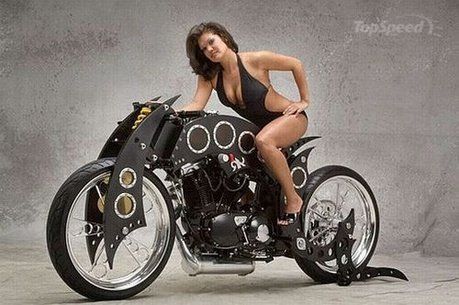via : the Motorcycle Hall of Fame
 One of New England's best-liked motorcyclists was Joe Bolger, a self-taught designer and engineer who worked in metal and wood in a small shop behind his home in Barre, Massachusetts. In 1974 he created a linked, rising-rate, long-travel suspension that was put into production as the OSSA BLT, meaning "Bolger Long Travel." He also designed an "equalizer" that reduced or eliminated chain flex, which was often the downfall of the early motocross machines with long-travel suspension. Also among the many patents he held was one for a bead breaker for those troublesome big tires on small ATV wheels.
One of New England's best-liked motorcyclists was Joe Bolger, a self-taught designer and engineer who worked in metal and wood in a small shop behind his home in Barre, Massachusetts. In 1974 he created a linked, rising-rate, long-travel suspension that was put into production as the OSSA BLT, meaning "Bolger Long Travel." He also designed an "equalizer" that reduced or eliminated chain flex, which was often the downfall of the early motocross machines with long-travel suspension. Also among the many patents he held was one for a bead breaker for those troublesome big tires on small ATV wheels.Joe Bolger was born in Charlottestown, Prince Edward Island, Canada in January, 1930.
"When I was a child," he recalled, "I was so fascinated with motorcycles that I would chase them down the road. My first motorcycle was a 1931 Indian Four that I bought when I was 14."
Bolger learned early to work with his hands, helping after school in his father's garage, doing both mechanical repair and bodywork. His formal education ended after the 8th grade.
"Times were hard and I had to get out and help make ends meet," he explained. "There was a military airfield on the island and I got work in 1943 as a water boy for crews of British pilots in training."

Following the war, the situation was even more difficult, and Bolger pulled up stakes and moved to the United States at the age of 16, finding work in a furniture factory for 79 cents an hour. He managed to save enough, however, to buy a motorcycle, paying $700 for a new 650cc Triumph with a rigid frame.

"I couldn't afford the extra $70 for the optional sprung rear hub model," he said. "Besides, I figured $7 per millimeter was too much to pay for a rear suspension."
Although still a Canadian citizen, Bolger served in the U.S. Army from 1951 through 1953 and was stationed in Germany and France.

Bolger started racing in 1956 aboard a 500cc AJS. He was a proficient racer and won the New England scrambles championship in both 1964 and 1965. As an organizer, he was instrumental in establishing popular Northeast vs. Canada off-road racing events in the 1960s.
As Bolger became more involved in motorcycling at a sporting level, he began to use his self-taught engineering skills to improve his racing motorcycles, and after 17 years at the furniture factory he quit to partner in a dealership, selling Yamaha, Honda, Triumph, BMW, and Kawasaki motorcycles. Meanwhile, he was continuing to fabricate lighter and better working parts for his racing motorcycles.

"Other riders would see these parts on my bikes, and they would ask where they could buy them," he said. "Soon I was building enough special foot pegs, motor mounts, lightweight wheels, and other parts that Motocross Engineers began to offer them through its catalog."
With his specialty part design and manufacturing business growing, in 1972 Bolger sold his interest in the retail shop to devote himself fulltime to engineering and design. He designed special tools made to work on particular parts of motorcycles, several of which were picked up by Honda and made available to dealerships.
While many of Bolger’s inventions were very successful, he admits that, like most inventors, not everything always worked exactly as envisioned.
"With my bikes, I tried all manner of crazy things. Many of those 'improvements' weren’t improvements at all, but I was always experimenting and fooling around with bikes. I had a good time working with them – and of course the older and slower I got, the more desperately I modified my motorcycles to offset what nature was doing to me."

He gained national prominence in 1975 when Yankee Motors purchased a large advertisement in the November 4th issue of Cycle News to announce its BLT OSSA, boasting more than eight inches of rear suspension travel. Nearly 30 years later at Vintage Motorcycle Days in Lexington, Ohio, nine vintage OSSA BLTs were on display. Such a grouping was very rare, since fewer than 150 of these machines were ever produced.
During his storied career in motorcycling, Bolger also was a contributing editor for Cycle World and Cycle Sport magazines.
When inducted into the Hall of Fame, Bolger had plenty of work to keep Joe Bolger Products, Inc. busy, but he found enough spare time to work on a vehicle modeled after a three-wheeled Morgan. Though it looked like it rolled out of the 1930s, Bolger's machine, using a Honda CX650 engine, was high-tech from the ground up, featuring shaft drive and torsion bar suspension. Every inch of the rolling chassis, including its hand-shaped aluminum body panels, was designed and built by Bolger. He planned to have his three-wheeled wonder on the road by the summer of 2005.
Bolger was the kind of man would could solve complex problems with a combination of common sense, hard work and the simple desire to stay in the workshop until the job was done right.
.












No comments:
Post a Comment